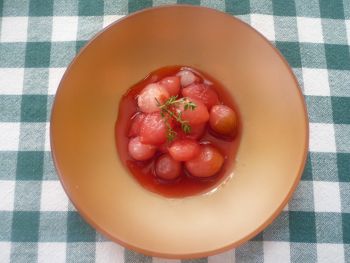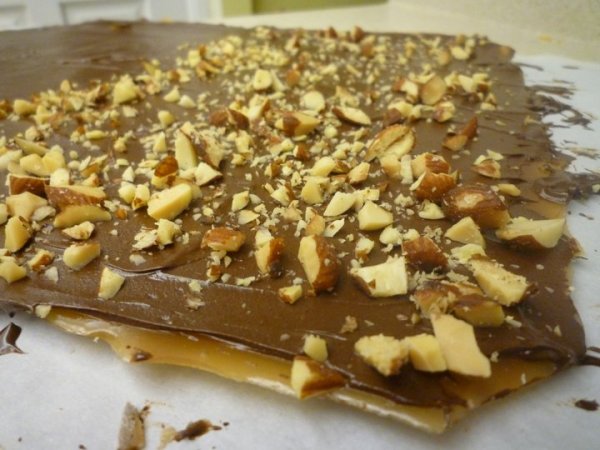Regular readers of this blog will recall my Home Alone style dash through the Frankfurt airport, induced by the scent of warm soft pretzels (laugenbrezel!), and the subsequent foray into the chemistry that gives us this glorious bread. Ah yes, we donned our gloves and surgical masks together, avoided recreating any particularly cringe-worthy scenes from Fight Club, and discovered that sometimes you have to be a little brave to make the magic happen.
It appears that suddenly the rest of the world has discovered that pretzels are that good, because it seems like every restaurant is offering sandwiches on pretzel buns now. The nerve! Yes, restaurant industry, thanks for waiting until I went gluten-free to shove advertisements for pretzel rolls in my face at every turn. But it’s like they say: Don’t get mad, get even.
And I found the perfect opportunity on a chilly Sunday over the weekend to do just that. With leftover mornay sauce from the previous night’s macaroni and cheese just begging to be reheated as cheese dip, clearly, it was time to take back the pretzel.
The process for making gluten-free pretzels is pretty similar to making traditional pretzels. There are some differences in the dry ingredients in order to add more acid and give the dough that chewy tenderness, but the main difference I found is purely tactile. The gluten-free dough feels much less stiff, so it took more care and a lighter touch to roll it out. I’d recommend keeping a little bowl of sweet rice flour nearby to flour your hands with, because it’s pretty likely that the warmth from your hands will make the dough stick to them otherwise. The other main difference is kind of awesome: only one rise! So basically, you get your pretzels twice as fast. Hallelujah!
Gluten Free Soft Pretzels
- 3 1/4 cups gluten-free flour blend (here’s mine!), plus ¼ – ½ cup extra
- 1 1/2 tsp. xanthan gum
- ½ cup dry buttermilk powder
- 1 package rapid-rise or instant yeast
- 1/4 teaspoon cream of tartar
- 1/4 teaspoon baking soda
- 1 tbsp. dark brown sugar or barley malt syrup
- 1 tsp. kosher salt
- 1 tsp. rice vinegar or cider vinegar
- 2 tbsp. unsalted butter, softened
- 2 egg whites
- 1 ½ cups warm water, about 110 degrees
- 1 oz. food grade lye
- Coarse salt or pretzel salt
- Plastic gloves, safety goggles, vinegar, and nonreactive pans and utensils.
Line two baking sheets with parchment paper and set them aside.
Combine the flour blend, xanthan gum, buttermilk powder, yeast, cream of tartar, baking soda, brown sugar, and salt in a large bowl and mix well.
 Add the vinegar, butter, and egg whites to the dry ingredients and mix well, then add the water in a slow steady stream. Once all of the water has been added, turn the mixer to a high speed and mix for 2-3 minutes. The dough will be loose and wet.
Add the vinegar, butter, and egg whites to the dry ingredients and mix well, then add the water in a slow steady stream. Once all of the water has been added, turn the mixer to a high speed and mix for 2-3 minutes. The dough will be loose and wet.
 Turn the mixer speed down to low and add flour 1 tbsp. at a time just until the dough begins to pull away from the sides of the bowl. It will still be quite tacky. Use a dough scraper to turn the dough out onto a silpat or lightly floured board, then knead lightly until smooth. Divide it into 12-16 equal pieces, depending on how large you would like the rolls to be. From here, you can either roll the dough into balls OR roll out into thin ropes and form into the traditional pretzel shape.
Turn the mixer speed down to low and add flour 1 tbsp. at a time just until the dough begins to pull away from the sides of the bowl. It will still be quite tacky. Use a dough scraper to turn the dough out onto a silpat or lightly floured board, then knead lightly until smooth. Divide it into 12-16 equal pieces, depending on how large you would like the rolls to be. From here, you can either roll the dough into balls OR roll out into thin ropes and form into the traditional pretzel shape.


 Set the rolls onto the prepared baking sheet, cover lightly with plastic wrap, and allow them to rise in a warm place for 45 minutes. They will puff up, but will not quite double in size.
Set the rolls onto the prepared baking sheet, cover lightly with plastic wrap, and allow them to rise in a warm place for 45 minutes. They will puff up, but will not quite double in size.
Now it’s time for the lye bath. Put on your gloves and safety goggles, and wipe down the surface of your workstation with plain white vinegar. Keep a small glass of vinegar nearby to neutralize any spills of the lye solution.
 Measure one quart of cool water into a nonreactive saucepan. Slowly add one ounce of food grade lye and stir gently to dissolve. ALWAYS add the lye to the water and not the water to the lye. Doing it the other way around may cause the lye to react and combust.
Measure one quart of cool water into a nonreactive saucepan. Slowly add one ounce of food grade lye and stir gently to dissolve. ALWAYS add the lye to the water and not the water to the lye. Doing it the other way around may cause the lye to react and combust.
 Dip each pretzel in the lye solution for 30 seconds and then place back on the parchment-lined baking sheet using a slotted spoon. When finished, wipe down any surfaces that may have come into contact with lye with a vinegar soaked rag, and then with warm soap and water.
Dip each pretzel in the lye solution for 30 seconds and then place back on the parchment-lined baking sheet using a slotted spoon. When finished, wipe down any surfaces that may have come into contact with lye with a vinegar soaked rag, and then with warm soap and water.
Sprinkle the pretzels with coarse salt and then let them rest while the oven is preheating.
Preheat the oven to 375 degrees F. Bake the pretzels for 20-30 minutes or until they are a deep golden brown.


 Cool completely on a wire rack prior to storing.
Cool completely on a wire rack prior to storing.
To save pretzels for later enjoyment, wrap individual pretzels in plastic wrap and then put them in a zip-top bag in the refrigerator or freezer. These reheat beautifully in the toaster or toaster oven, so you don’t have to worry about the leftovers going to waste. Perfect for slider-style sandwiches, cheese dip, mustard, or just alongside a cup of coffee, they are a hit out of the park.
So the next time some chain restaurant’s advertisement comes blaring through your television or radio praising their “artisan,” “hand-crafted,” or “revolutionary” pretzel buns… remember that you’ve totally got the power to make them even better.
Ciao for now,
Neen








Leave a comment